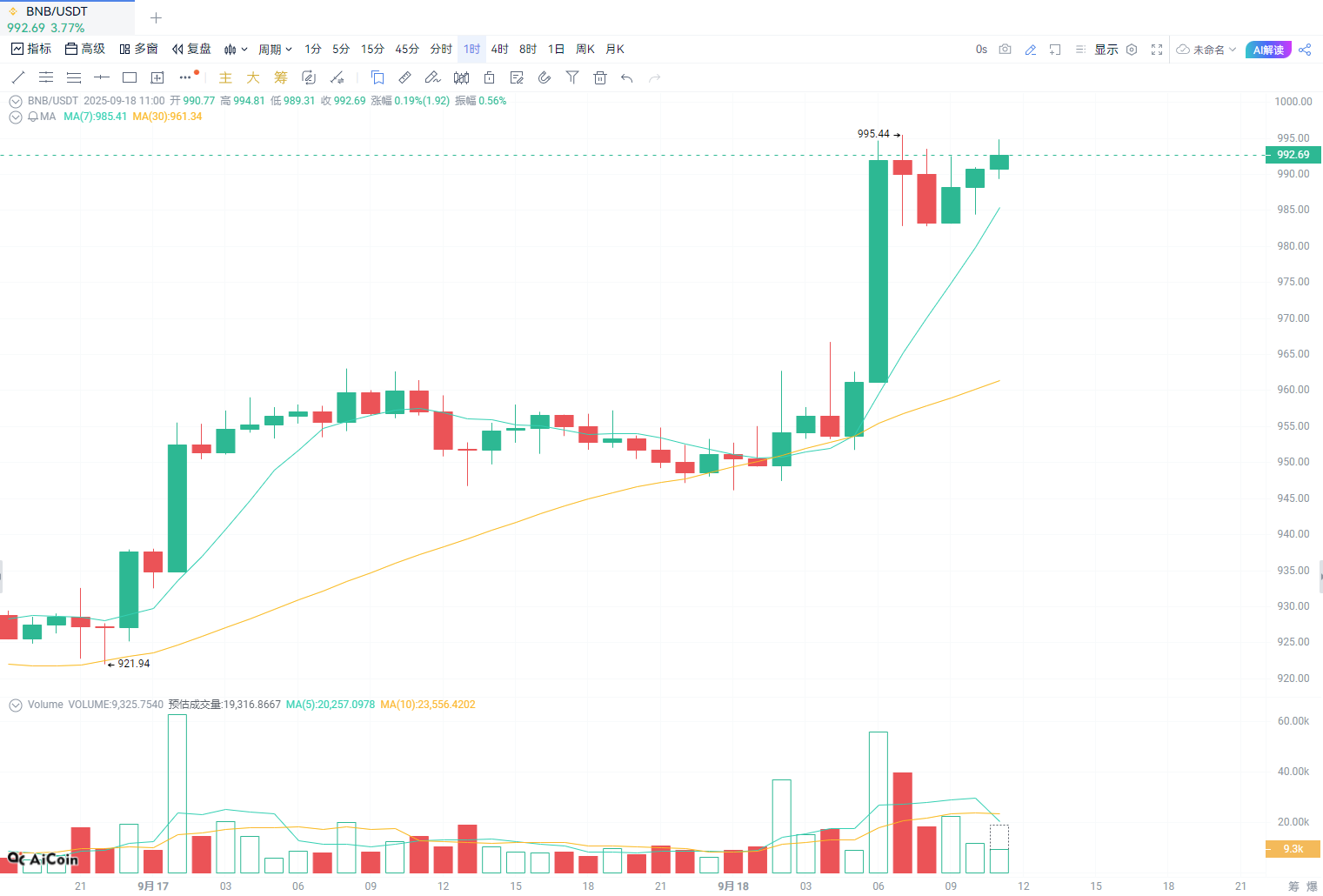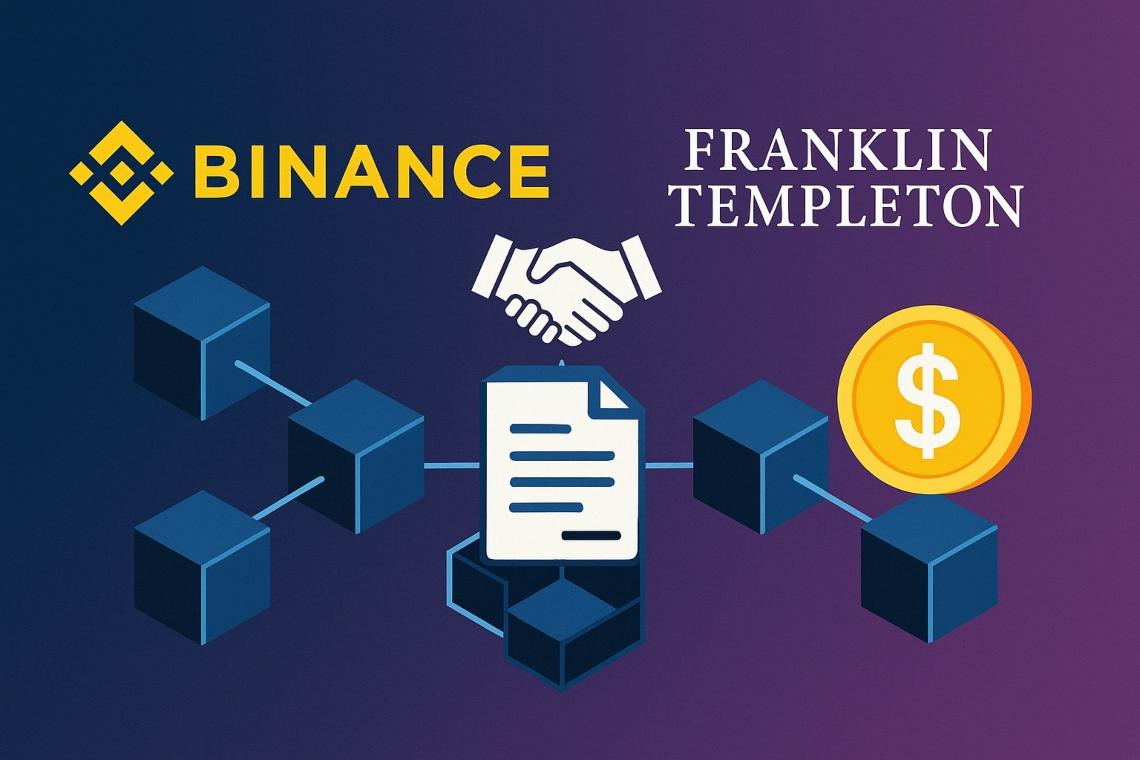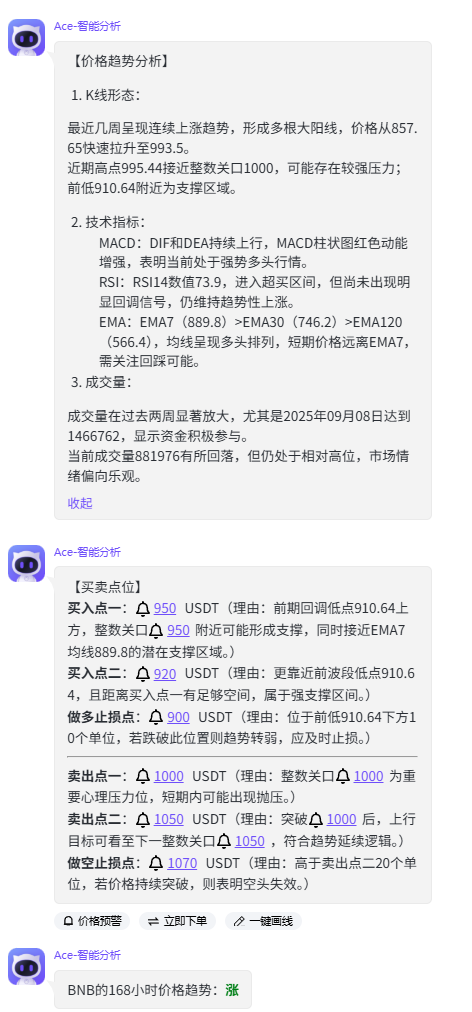On the morning of September 18, Binance's native token BNB reached an all-time high of $995.44, soaring over 3% from the previous day, with a market cap easily surpassing $138.4 billion. This is not a blind speculative frenzy, but rather the result of multiple forces including supply contraction, ecological expansion, and institutional entry.

Deflationary Model: The Supply Iron Law Created by the Burn Mechanism
According to official data from BNB Chain, over 60 million BNB have been burned since 2025, reducing the circulating supply from approximately 145 million at the beginning of the year to the current 139.18 million. This figure is not arbitrary: the 32nd quarterly burn event in the third quarter was completed in July, permanently destroying 1.579 million BNB, valued at about $950 million. The amount burned is dynamically adjusted based on BNB's price and trading volume—higher prices lead to more burns, creating a self-reinforcing deflationary cycle. Currently, the circulating supply of BNB has reached a 20-month low of 139.187 million, nearly 20% lower than the same period last year.
Imagine this: when market sentiment turns optimistic, every purchase under fixed supply feels like squeezing through an increasingly narrow pipeline. In the first half of 2025, BNB's market value-to-supply ratio (MVRV) has risen to near historical highs, indicating that holders have an average profit margin of up to 150%. The Federal Reserve's confirmation of a 25 basis point rate cut in September will further convert BNB's deflationary pressure into price rocket fuel.
Critics question its reliance on the centralized elements of the Binance exchange—the burn funds mainly come from platform fees, and any regulatory storm could disrupt this chain. However, data from 2025 refutes this concern: even amid tightening global crypto regulations, BNB's burn execution rate remains above 99%. More importantly, the Lorentz/Maxwell hard fork upgrade of BNB Chain has reduced gas fees by 95%, to an average of $0.01 per transaction. This not only lowers the usage threshold but also indirectly enhances burn efficiency, as more transactions mean more fees flowing back to the burn pool.
The deep value of deflation lies in its commitment to long-term holders. In a market filled with infinitely issued stablecoins and meme coins, BNB's "hard cap" acts like an iron gate, blocking dilution risks. The burn report from July 2025 shows that the total value burned has exceeded $20 billion, equivalent to nearly 40% of the initial total supply. For institutional investors, this represents a quantifiable "scarcity premium"—similar to the limited mining of gold, but in code form, it never expires. Currently, BNB's daily active addresses have surged to 1.56 million, setting a new high for 2025. When the supply curve bends downward and the demand curve rises upward, the logic of price becomes evident: $1000 is not the end, but the next milestone.
Ecological Prosperity: A Demand Surge Amid the dApp Craze
If deflation is the "supply heart" of BNB, then the ecological expansion of BNB Chain is its "demand lungs." In the third quarter of 2025, this Layer-1 network has rapidly transformed from a DeFi stronghold into a full-stack Web3 infrastructure, with the number of dApps surpassing 5000 and on-chain transaction volume increasing by 19% month-on-month.
BNB Chain's Total Value Locked (TVL) has reached $7.75 billion, setting a new high in 3.5 years. This is thanks to the leading native DEX PancakeSwap: the protocol's monthly trading volume reached $188 billion, ranking first across the chain. Daily active users (DAUs) have soared to 4.2 million, with weekly transaction counts reaching 85 million and a median gas fee of only $0.0085. The Q3 report shows that BNB Chain's cross-chain bridging activities grew by 41%, with DeFi TVL's overall market share rising from 12% in the same period last year to 18%.
The prosperity of the ecosystem stems from the blossoming of multi-dimensional application scenarios. DeFi remains a pillar, but gaming and RWA (real-world assets) sectors are emerging strongly. In 2025, the number of gaming dApp users on BNB Chain exceeded 100 million, contributing 30% of the on-chain traffic. Meanwhile, RWA projects such as tokenized bonds and real estate funds have attracted over $1 billion in funding. All these applications require BNB as "fuel" for gas fees—each transaction reinforces the organic demand for the token.
This wave of growth is not due to luck but the result of strategic planning. BNB Chain's five-year anniversary report highlights that the total number of unique addresses has exceeded 615 million, and the developer community has expanded to over 5000. Compared to Ethereum's high gas fees (averaging $0.50 per transaction), BNB's low-cost advantage is like a scalpel, cutting through user hesitation. In the first half of 2025, daily transaction volume surged from 4.1 million to 9.9 million, proving the network's "economies of scale" effect.
Although BNB Chain is decentralized, the shadow of Binance still looms large. Regulators may view it as a "exchange chain," imposing additional scrutiny. But the data speaks for itself: in Q3 2025, BNB Chain's DeFi trading volume surpassed that of Ethereum and Solana combined. This surge in demand is transforming BNB from a "transaction fee token" into a "network currency," amplifying its price elasticity. Analysts predict that if TVL breaks $10 billion by the end of the year, BNB's gas fee consumption will further increase demand pressure by an additional 10%-15%.
Institutional Interest: RWA Alliance Ignites Market Sentiment
On September 10, 2025, Binance's announcement of a partnership with Franklin Templeton for RWA collaboration instantly pushed BNB to a new high of $907. This traditional giant, managing over $15 trillion in assets, will work with Binance to develop compliant tokenized securities products, expected to launch by the end of the year.

The impact of the partnership was immediate: the RWA market grew by 107% in 2025, exceeding $12.35 billion. BNB, as a bridging asset, directly benefited—within 24 hours of the announcement, its price surged by 29%, with a cumulative increase of 75% for the year. Franklin's entry not only injected liquidity but also enhanced BNB's "compliance halo." Previously, institutions like CEA Industries and Nano Labs had allocated $2.25 billion to BNB positions.
Meanwhile, sentiment in the futures and derivatives markets is high. The 24-hour trading volume of BNB perpetual contracts reached $1.67 billion, with open interest (OI) remaining steady at $1.65 billion. Year-to-date OI has grown by 14%, reaching $3.1 billion. The long-short ratio indicates that institutional longs dominate, with moderate leverage increases. This reflects market confidence in BNB: it is not just speculation but a fundamental-based allocation.
Institutional interest is not charity. Franklin chose BNB because its on-chain RWA infrastructure is already mature—by 2025, BNB Chain processed over 20% of global tokenized asset transactions. However, it is important to note that geopolitical issues or SEC scrutiny could reverse sentiment.
A Review of BNB's Journey:
November 2017: Issued, priced at $1
Early 2018: BNB price surpassed $10, becoming one of the best-performing crypto assets at the time
February 2021: Crypto bull market, surpassed $100
September 2025: Approaching $1000

How Much Further Can BNB Rise?
There are some predictions in the market for reference:
2025: In an optimistic scenario, BNB price could reach $1,000 - $1,200
2030: With the widespread adoption and application of blockchain technology, BNB price could challenge $2,800
Gentle Reminder: Predictions are for reference only and are not investment advice.
This article is for informational sharing only and does not constitute any investment advice for anyone.
Join our community to discuss and grow stronger together!
Official Telegram community: https://t.me/aicoincn
AiCoin Chinese Twitter: https://x.com/AiCoinzh
OKX Benefits Group: https://aicoin.com/link/chat?cid=l61eM4owQ
Binance Benefits Group: https://aicoin.com/link/chat?cid=7JmRjnl3w
免责声明:本文章仅代表作者个人观点,不代表本平台的立场和观点。本文章仅供信息分享,不构成对任何人的任何投资建议。用户与作者之间的任何争议,与本平台无关。如网页中刊载的文章或图片涉及侵权,请提供相关的权利证明和身份证明发送邮件到support@aicoin.com,本平台相关工作人员将会进行核查。




